Summary
The effect of lipolytic stimulants on cyclic AMP levels and glycerol production is strongly dependent on the concentration of fat cells in the incubation medium. After addition of noradrenaline cyclic AMP levels in diluted fat cell suspensions (20 000 cells/ml) reached 10 fold higher levels and declined much more slowly than in concentrated cell suspensions (100 000 cells/ml). An inhibitory substance appeared in the incubation medium which, after addition to a suspension of fresh fat cells caused a dose-dependent inhibition of hormone effects. The inhibitor was produced during preincubation periods of the fat cells and was removed by washing the cells with fresh medium.
Purification of the medium by acid extraction, gel filtration, thin layer chromatography and the identification by gas chromatography showed that the inhibitor released represents adenosine. After incubation with adenosine deaminase the inhibitory activity of the medium disappeared. No inhibitory activity was obtained from the incubation medium by solvent extraction, a procedure which fully recovered added PGE2. Adenosine appeared in the medium after 5 min of incubation of fat cells and reached maximal levels (0.2 nmol/ml/105 cells) after 20 min. Noradrenaline (10 μM) did not stimulate the release of adenosine from fat cells. Addition of 0.01 to 0.1 μM of adenosine to fat cells effectively inhibited cyclic AMP accumulation and lipolysis induced by noradrenaline. Hence, a delayed rise and the secondary decline of cyclic AMP levels after hormonal stimulation can be accounted for by adenosine released from fat cells.
Similar content being viewed by others
References
Butcher, R. W., Baird, C. E.: Effects of prostaglandins on adenosine 3′,5′-monophosphate in fat and other tissuses. J. biol. Chem. 243, 1713–1717 (1968).
Butcher, R. W., Baird, C. E., Sutherland, E. W.: Effects of lipolytic and antilipolytic substances on adenosine 3′,5′-monophosphate levels in isolated fat cells. J. biol. Chem. 243, 1705–1712 (1968).
Butcher, R. W., Ho, R. J., Meng, H. C., Sutherland, E. W.: Adenosine-3′,5′-monophosphate in biological materials. II. The measurement of adenosine-3′,5′-monophosphate in tissues and the role of the cyclic nucleotide in the lipolytic response of fat to epinephrine. J. biol. Chem. 240, 4515–4523 (1965).
Chen, R. F.: Removal of fatty acids from serum albumin by charcoal treatment. J. biol. Chem. 242, 173–181 (1967).
Christ, E. J., Nugteren, D. H.: The biosynthesis and possible function of prostaglandins in adipose tissue. Biochim. biophys. Acta (Amst.) 218, 296–307 (1970).
Craig, J. W., Rall, T. W., Larner, J.: The influence of insulin and epinephrine on adenosine 3′,5′-phosphate and glycogen transferase in muscle. Biochim. biophys. Acta (Amst.) 177, 213–219 (1969).
Davies, J. I.: In vitro regulation of the lipolysis of adipose tissue. Nature (Lond.) 218, 349–352 (1968).
Dole, V. P.: Effect of nucleic acid metabolites on lipolysis in adipose tissue. J. biol. Chem. 236, 3125–3130 (1961).
Ebert, R., Schwabe, U.: Antilipolytic effect of adenosine and purine bases in isolated fat cells. Acta pharmacol. (Kbh.) 29, Suppl. 4, 10 (1971).
Fain, J. N., Pointer, R. H., Ward, W. F.: Effect of adenosine nucleosides on adenylate cyclase, phosphodiesterase, cyclic adenosine monophosphate accumulation and lipolysis in fat cells. J. biol. Chem. 247, 6866–6872 (1972).
Gilman, A. G.: A protein binding assay for adenosine 3′,5′-cyclic monophosphate. Proc. nat. Acad. Sci. (Wash.) 67, 305–312 (1970).
Hepp, D., Challoner, D. R., Williams, R. H.: Studies on the action of insulin in isolated adipose tissue cells. J. biol. Chem. 243, 4020–4026 (1968).
Ho, R. J., Sutherland, E. W.: Formation and release of a hormone antagonist by adipocytes. J. biol. Chem. 246, 6822–6827 (1971).
Illiano, G., Cuatrecasas, P.: Endogenous prostaglandins modulate lipolytic processes in adipose tissue. Nature (Lond.) New Biol. 234, 72–74 (1971).
Kakiuchi, S., Rall, T. W.: The influence of chemical agents on the accumulation of adenosine 3′,5′-phosphate in slices of rabbit cerebellum. Molec. Pharmacol. 4, 367–378 (1968).
Kalkar, H. M.: Differential spectrophotometry of purine compounds by means of specific enzymes. II. Determination of adenine compounds. J. biol. Chem. 167, 445–459 (1947)
Kappeler, H.: Zur Pharmakologie der Lipolysehemmung. I. Wirkungsweise adenosinhaltiger Nucleoside und Nucleotide auf die Lipolyse des Fettgewebes in vitro. Diabetologia 2, 52–61 (1966).
Lambert, M., Neish, A. C.: Rapid method for estimation of glycerol in fermentation solutions. Canad. J. Res., Sect. B 28, 83–89 (1950).
Manganiello, V. C., Murad, F., Vaughan, M.: Effects of lipolytic and antilipolytic agents on cyclic 3′,5′-adenosine monophosphate in fat cells. J. biol. Chem. 246, 2195–2202 (1971).
Moriwaki, K., Foa, P. P.: Inhibition of rat liver adenyl cyclase by adenosine and adenine nucleotides. Experientia (Basel) 26, 22 (1970).
Nash, T.: The colorimetric estimation of formaldehyde by means of the Hantzsch reaction. Biochem. J. 55, 416–421 (1953).
Pereira, J. N., Holland, G. F.: The effect of nicotinamide adenine dinucleotide on lipolysis in adipose tissue in vitro. Experienta (Basel) 22, 658–659 (1966).
Robison, G. A., Butcher, R. W., Øye, I., Morgan, H. E., Sutherland, E. W.: The effect of epinephrine on adenosine 3′,5′-phosphate levels in the isolated perfused rat heart. Molec. Pharmacol. 1, 168–177 (1965).
Rodbell, M.: Metabolism of isolated fat cells. J. biol. Chem. 239, 375–380 (1964).
Sattin, A., Rall, T. W.: The effect of adenosine and adenine nucleotides on the cyclic adenosine 3′,5′-phosphate content of guinea pig cerebral cortex slices. Molec. Pharmacol. 6, 13–23 (1970).
Schwabe, U., Ebert, R.: Different effects of lipolytic hormones and phosphodiesterase inhibitors on cyclic 3′,5′-AMP levels in isolated fat cells. Naunyn-Schmiedeberg's Arch. Pharmacol. 274, 287–298 (1972).
Shaw, J. E., Ramwell, P. W.: Release of prostaglandin from rat epididymal fat pad on nervous and hormonal stimulation. J. biol. Chem. 243, 1498–1503 (1968).
Shimizu, H., Daly, J.: Formation of cyclic adenosine 3′,5′-monophosphate from adenosine in brain slices. Biochim. biophys. Acta (Amst.) 222, 465–473 (1970).
Steinberg, D., Vaughan, M., Nestel, P. J., Strand, O., Bergström, S.: Effects of prostaglandins on hormone-induced mobilization of free fatty acids. J. clin. Invest. 43, 1533–1540 (1964).
Unger, W. G., Stamford, I. F., Bennet, A.: Extraction of prostaglandins from human blood. Nature (Lond.) 233, 336–337 (1971).
Uziel, M., Cohn, W. E.: Desalting of nucleotides by gel filtration. Biochim. biophys. Acta (Amst.) 103, 539–541 (1965).
Weiss, B., Davies, J. I., Brodie, B. B.: Evidence for a role of adenosine 3′,5′-monophosphate in adipose tissue lipolysis. Biochem. Pharmacol. 15, 1553–1561 (1966).
Westermann, E., Stock, K., Bieck, P.: Phenylisopropyl-Adenosin (PIA): Ein potenter Hemmstoff der Lipolyse in vivo und in vitro. Fettstoffwechsel 5, 68–73 (1969).
Author information
Authors and Affiliations
Rights and permissions
About this article
Cite this article
Schwabe, U., Ebert, R. & Erbler, H.C. Adenosine release from isolated fat cells and its significance for the effects of hormones on cyclic 3′,5′-AMP levels and lipolysis. Naunyn-Schmiedeberg's Arch. Pharmacol. 276, 133–148 (1973). https://doi.org/10.1007/BF00501186
Received:
Issue Date:
DOI: https://doi.org/10.1007/BF00501186




